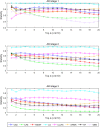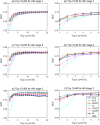Feature Ranking in Predictive Models for Hospital-Acquired Acute Kidney Injury
- PMID: 30470779
- PMCID: PMC6251919
- DOI: 10.1038/s41598-018-35487-0
Feature Ranking in Predictive Models for Hospital-Acquired Acute Kidney Injury
Abstract
Acute Kidney Injury (AKI) is a common complication encountered among hospitalized patients, imposing significantly increased cost, morbidity, and mortality. Early prediction of AKI has profound clinical implications because currently no treatment exists for AKI once it develops. Feature selection (FS) is an essential process for building accurate and interpretable prediction models, but to our best knowledge no study has investigated the robustness and applicability of such selection process for AKI. In this study, we compared eight widely-applied FS methods for AKI prediction using nine-years of electronic medical records (EMR) and examined heterogeneity in feature rankings produced by the methods. FS methods were compared in terms of stability with respect to data sampling variation, similarity between selection results, and AKI prediction performance. Prediction accuracy did not intrinsically guarantee the feature ranking stability. Across different FS methods, the prediction performance did not change significantly, while the importance rankings of features were quite different. A positive correlation was observed between the complexity of suitable FS method and sample size. This study provides several practical implications, including recognizing the importance of feature stability as it is desirable for model reproducibility, identifying important AKI risk factors for further investigation, and facilitating early prediction of AKI.
Conflict of interest statement
The authors declare no competing interests.
Figures




Similar articles
-
An effective multi-step feature selection framework for clinical outcome prediction using electronic medical records.BMC Med Inform Decis Mak. 2025 Feb 17;25(1):84. doi: 10.1186/s12911-025-02922-y. BMC Med Inform Decis Mak. 2025. PMID: 39962480 Free PMC article.
-
Predicting AKI in emergency admissions: an external validation study of the acute kidney injury prediction score (APS).BMJ Open. 2017 Mar 8;7(3):e013511. doi: 10.1136/bmjopen-2016-013511. BMJ Open. 2017. PMID: 28274964 Free PMC article.
-
Machine Learning Model for Risk Prediction of Community-Acquired Acute Kidney Injury Hospitalization From Electronic Health Records: Development and Validation Study.J Med Internet Res. 2020 Aug 4;22(8):e16903. doi: 10.2196/16903. J Med Internet Res. 2020. PMID: 32749223 Free PMC article.
-
Electronic Health Record-Enabled Big-Data Approaches to Nephrotoxin-Associated Acute Kidney Injury Risk Prediction.Pharmacotherapy. 2018 Aug;38(8):804-812. doi: 10.1002/phar.2150. Epub 2018 Jul 13. Pharmacotherapy. 2018. PMID: 29885015 Review.
-
Risk Prediction Models for Acute Kidney Injury in Critically Ill Patients: Opus in Progressu.Nephron. 2018;140(2):99-104. doi: 10.1159/000490119. Epub 2018 May 31. Nephron. 2018. PMID: 29852504 Free PMC article. Review.
Cited by
-
Risk Stratification for Postoperative Acute Kidney Injury in Major Noncardiac Surgery Using Preoperative and Intraoperative Data.JAMA Netw Open. 2019 Dec 2;2(12):e1916921. doi: 10.1001/jamanetworkopen.2019.16921. JAMA Netw Open. 2019. PMID: 31808922 Free PMC article.
-
An effective multi-step feature selection framework for clinical outcome prediction using electronic medical records.BMC Med Inform Decis Mak. 2025 Feb 17;25(1):84. doi: 10.1186/s12911-025-02922-y. BMC Med Inform Decis Mak. 2025. PMID: 39962480 Free PMC article.
-
Characterization of Risk Prediction Models for Acute Kidney Injury: A Systematic Review and Meta-analysis.JAMA Netw Open. 2023 May 1;6(5):e2313359. doi: 10.1001/jamanetworkopen.2023.13359. JAMA Netw Open. 2023. PMID: 37184837 Free PMC article.
-
Internal and External Validation of Machine Learning Models for Predicting Acute Kidney Injury Following Non-Cardiac Surgery Using Open Datasets.J Pers Med. 2024 May 30;14(6):587. doi: 10.3390/jpm14060587. J Pers Med. 2024. PMID: 38929808 Free PMC article.
-
A two-tier feature selection method for predicting mortality risk in ICU patients with acute kidney injury.Sci Rep. 2024 Jul 22;14(1):16794. doi: 10.1038/s41598-024-63793-3. Sci Rep. 2024. PMID: 39039115 Free PMC article.
References
-
- Flechet M, et al. AKIpredictor, an online prognostic calculator for acute kidney injury in adult critically ill patients: development, validation and comparison to serum neutrophil gelatinase-associated lipocalin. Intensive Care Med. 2017;43(6):764–773. doi: 10.1007/s00134-017-4678-3. - DOI - PubMed
-
- Wang, X., Sontag, D. & Wang, F. Unsupervised Learning of Disease Progression Models. Proceedings of the 20th ACM SIGKDD international conference on Knowledge discovery and data mining. 85–94 (2014).
Publication types
MeSH terms
Grants and funding
LinkOut - more resources
Full Text Sources
Medical

